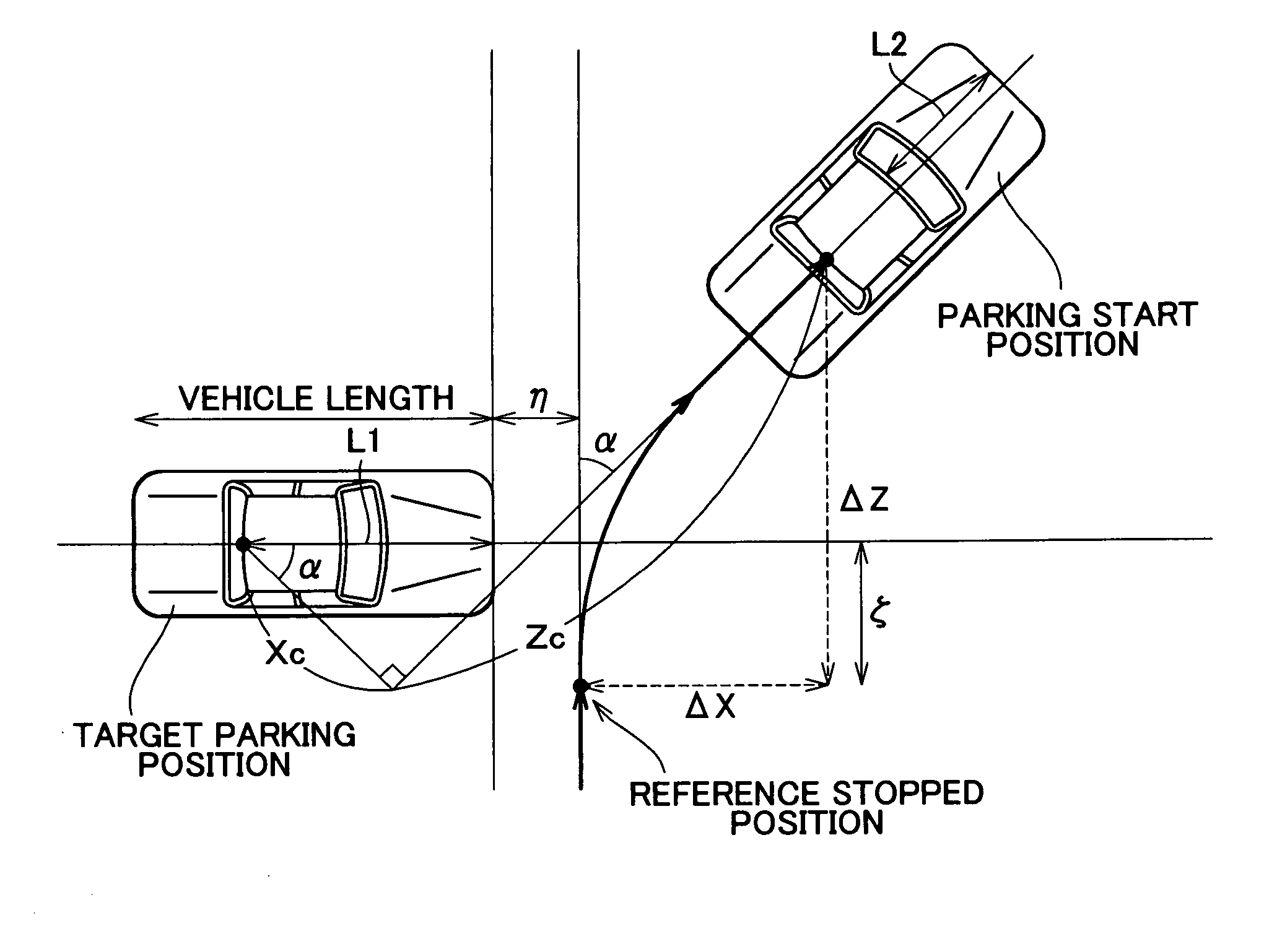Parking assist apparatus and parking assist method for vehicle
a technology for parking assist and vehicles, which is applied in the direction of braking systems, instruments, television systems, etc., can solve the problems of user inconvenience of going through the positional adjustment the accuracy limit of estimating the initial position of the target parking frame, etc., and achieve the effect of reducing the frequency of recognition of the target parking position
- Summary
- Abstract
- Description
- Claims
- Application Information
AI Technical Summary
Benefits of technology
Problems solved by technology
Method used
Image
Examples
first embodiment
[0052]In the first embodiment, when the control parameters (Xc, Zc, θ) are determined, the parking assist ECU 12 stores the control parameters (Xc, Zc, θ) into the predetermined rewritable storage means 12a (e.g., the RAM of the parking assist ECU 12). At this time, the control parameters (Xc, Zc, θ) are stored and managed separately for garage parking and parallel parking.
[0053]Specifically, in the case of garage parking, values of the control parameters (Xc, Zc) are classified in storage in accordance with the angle θ of the vehicle to be angled to the target parking position (hereinafter, this control parameter will be referred to as “deflection angle θ”) as shown in FIG. 5. In this embodiment, ranges of the deflection angle θ are set for every 10 degrees in the positive and negative directions from 0 degree. The sign of the deflection angle θ in FIG. 5 is defined so that a leftward deflection of the vehicle as in FIG. 4B (i.e., a counterclockwise deflection from a vehicular long...
second embodiment
[0086]Next, a parking assist apparatus in accordance with the invention will be described. The parking assist apparatus of this embodiment estimates the deflection angle θ by an estimation technique as described above on the basis of the driving state of the vehicle up to the parking start position, and also estimates the aforementioned control parameters (Xc, Zc).
[0087]FIG. 8 is a diagram illustrating a technique for estimating the control parameters (Xc, Zc) in accordance with this embodiment. In this embodiment, the control parameter Xc (i.e., the x-coordinate of the center of the rear axle of the vehicle at the target parking position) is computed as in:
Xc=(L1+ΔX+η)•cos α−(ΔZ−ζ)•sin α (4)
[0088]The control parameter Z (i.e., the z-coordinate of the center of the rear axle of the vehicle at the target parking position) is computed as in:
Xc=(L1+ΔX+η)•sin α+(ΔZ−ζ)•cos α (5)
[0089]In the above-equations, L1 is the distance [m] from the center of the rear axle of the vehicle on a hor...
third embodiment
[0098]the parking assist apparatus of the invention will next be described.
[0099]This embodiment, as described in detail below, makes it possible to estimate the target parking position with high accuracy by detecting the stopped state of the vehicle and recognizing, as a target parking position, a position having a predetermined relation with the position of the vehicle occurring at the time of detection of the stopped state. Hence, it becomes possible to initial-display the target parking frame in a desired target parking position from the beginning.
[0100]FIG. 9 is a diagram illustrating a target parking position estimating method for garage parking in accordance with the embodiment. In the target parking position estimating method of this embodiment, a precondition is that, as indicated in FIG. 9, the vehicle approaches a target parking position perpendicularly thereto, and temporarily stops at a center of the target parking position (a center line of the target parking position ...
PUM
 Login to View More
Login to View More Abstract
Description
Claims
Application Information
 Login to View More
Login to View More - R&D
- Intellectual Property
- Life Sciences
- Materials
- Tech Scout
- Unparalleled Data Quality
- Higher Quality Content
- 60% Fewer Hallucinations
Browse by: Latest US Patents, China's latest patents, Technical Efficacy Thesaurus, Application Domain, Technology Topic, Popular Technical Reports.
© 2025 PatSnap. All rights reserved.Legal|Privacy policy|Modern Slavery Act Transparency Statement|Sitemap|About US| Contact US: help@patsnap.com



